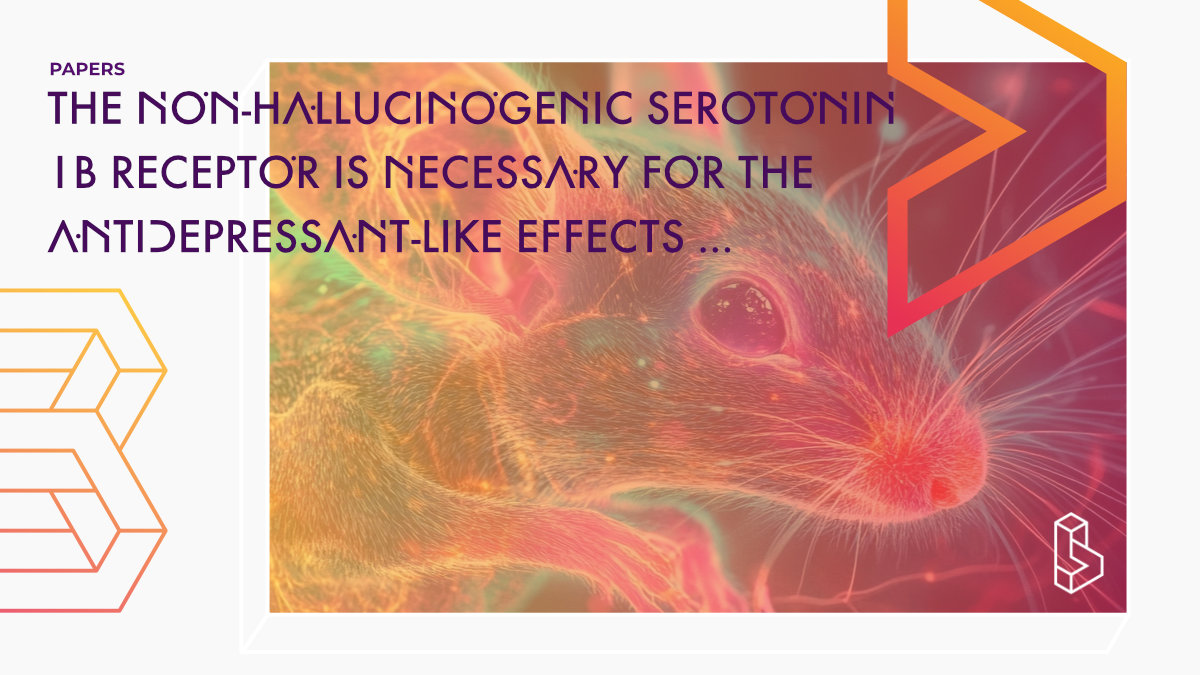This preprint mouse study (n=29) finds that the serotonin 1B receptor (5-HT1BR) is necessary for psilocybin’s antidepressant and anxiolytic effects, independent of its hallucinogenic properties. Using transgenic mice lacking 5-HT1BR and network analysis, the study demonstrates that this receptor influences brain-wide activity patterns and mediates acute and persistent behavioural responses to psilocybin, suggesting a novel mechanism for psilocybin’s therapeutic effects.
Abstract of The non-hallucinogenic serotonin 1B receptor is necessary for the antidepressant-like effects of psilocybin in mice
“Recent studies highlight the promising use of psychedelic therapies for psychiatric disorders, including depression. The persisting clinical effects of psychedelics such as psilocybin are commonly attributed to activation of the serotonin 2A receptor (5-HT2AR) based on its role in the acute hallucinatory effects. However, the active metabolite of psilocybin binds to many serotonin receptor subtypes, including the serotonin 1B receptor (5-HT1BR). Given the known role of 5-HT1BR in mediating depressive phenotypes and promoting neural plasticity, we hypothesized that it mediates the effects of psilocybin on neural activity and behavior. We first examined the acute neural response to psilocybin in mice lacking 5-HT1BR. We found that 5-HT1BR expression influenced brain-wide activity following psilocybin administration, measured by differences in the patterns of the immediate early gene c-Fos, across regions involved in emotional processing and cognitive function, including the amygdala and prefrontal cortex. Functionally, we demonstrated that 5-HT1BR is necessary for the acute and persisting behavioral effects of psilocybin. Although there was no effect of 5-HT1BR expression on the acute head twitch response, mice lacking 5-HT1BRs had attenuated hypolocomotor responses to psilocybin. We also measured the persisting antidepressant-like effects of psilocybin using transgenic and pharmacological 5-HT1BR loss-of-function models and found that 5-HT1B was required for the decreased anhedonia and reduced anxiety-like behavior. Finally, using a network analysis, we identified neural circuits through which 5-H1BR may modulate the response to psilocybin. Overall, our research implicates the 5-HT1BR, a non-hallucinogenic serotonin receptor, as a critical mediator of the behavioral and neural effects of psilocybin in mice.“
Authors: Sixtine Fleury & Katherine M. Nautiyal
Summary of The non-hallucinogenic serotonin 1B receptor is necessary for the antidepressant-like effects of psilocybin in mice
The prevalence of mood and anxiety disorders increases, particularly in the United States, where nearly 10% of adults are diagnosed with mood disorders and around 20% with anxiety disorders. Despite the widespread use of selective serotonin reuptake inhibitors (SSRIs) as conventional treatments, these medications often require prolonged use and do not provide relief for a significant number of patients. This gap in effective treatment emphasises the necessity for exploring novel therapeutic options, particularly those that act rapidly and demonstrate enduring effects.
Psychedelic compounds, including psilocybin, are emerging as promising candidates for treating psychiatric disorders. Previous studies have indicated their potential efficacy in alleviating major depressive disorder (MDD) and other related conditions. Psilocybin, the active compound in certain mushrooms, has shown to produce lasting antidepressant effects with minimal doses. However, the mechanisms behind these effects are not entirely understood, particularly whether the subjective experiences associated with psychedelics are essential for their therapeutic benefits. Earlier research predominantly highlighted the serotonin 2A receptor (5-HT2AR) as a key player in mediating the acute hallucinogenic effects of psilocybin. Nonetheless, the polypharmacology of psilocybin suggests that other serotonin receptors, such as the serotonin 1B receptor (5-HT1BR), may also play a significant role.
The authors hypothesise that the 5-HT1BR is crucial for the antidepressant-like effects of psilocybin. They propose that this receptor mediates psilocybin’s influence on neural activity and behaviour, particularly in relation to depressive phenotypes and neural plasticity. The introduction sets the stage for understanding how 5-HT1BR could be a target for developing effective non-hallucinogenic therapies for depression, thus broadening the scope of psychedelic research beyond the well-documented actions of 5-HT2AR.
Methods
Find this paper
https://doi.org/10.1101/2024.10.18.618582
Open Access | Google Scholar | Backup | 🕊
Cite this paper (APA)
Fleury, S., & Nautiyal, K. M. (2024). The non-hallucinogenic serotonin 1B receptor is necessary for the antidepressant-like effects of psilocybin in mice. bioRxiv, 2024-10.
Study details
Compounds studied
Psilocybin
Topics studied
Depression
Neuroscience
Study characteristics
Animal Study
Bio/Neuro
Participants
29
Rodents
Compound Details
The psychedelics given at which dose and how many times
Psilocybin 5 mg | 1x
